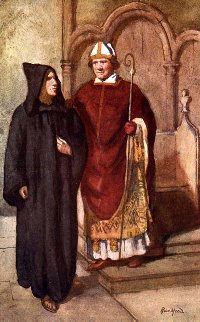
Abbot Samson & Brother Jocelyn
by Rose Mead 1907
|
The Abbots
of
St Edmund's
|
Introducing the Abbots
|
In about 635 King Sigeberht was said to have founded a monastery for himself at Beodericesworth, which is today called Bury St Edmunds. The minster church at that time was dedicated to St Mary. It is not known how long this foundation lasted, as Sigeberht was killed in about 640. If it continued, then it was probably abandoned around the time of the Danish incursions around 865.
Following the death of King Edmund in 869, his body was moved to Beodericsworth in about 906. Arrangements were made for secular guardians to protect his shrine. Around 925 it is reported that a more formal college of priests was appointed to run the shrine as a monastic institution.
In 945 King Edmund gave to the monastery all the royal revenues from the town of Bury St Edmunds to provide for its needs. The minster of St Edmund must have been a substantial monastic foundation by this time. The priests at this time are known as "secular" priests. This does not make them any less holy than Benedictines. It means that, instead of living a cloistered and isolated existence, they lived and worked within the local community. They were more like parish priests than monks.
Whatever the internal arrangements of the monastery and church from 906 to 1020, we do not have any record of the "abbots", until the so-called secular monks were evicted to be replaced by the newly fashionable Order of St Benedict.
The great abbey at Bury St Edmunds became a Benedictine foundation from 1020 when Bishop Ailwin, under King Canute, drafted in 20 Black Monks from St Benet Hulme in the Norfolk Broads, and Ely in the Fens, to replace the secular priests.
LIST OF THE BENEDICTINE ABBOTS OF
ST. EDMUND'S
- Uvius or Ufi, prior of St. Benet Hulme (1020).
- Leofstan (1044).
- Baldwin de St. Denis (1065).
- Robert I. (1100).
- Robert II. (1102).
- Albold (1114)
- Anselm (1121 and 1138).
- Ording (1138 and 1148)
- Hugh I. (1157)
- Samson de Tottington (1182)
- Hugh II (1215)
- Richard de Lisle (1229).
- Henry de Rushbrook (1234).
- Edmund de Walpole (1248).
- Simon de Luton (1257)
- John de Norwold (1279)
- Thomas de Tottington (1302)
- Richard de Draughton (1312)
- William de Bernham (1335)
- Henry de Hunstanton (1361)
- John de Brinkele (1361)
- * Edward Bromfield (1379)
- John de Tymworth (1384)
- William Cratfield (1390)
- William Excetre (1415)
- William Curteys (1429)
- William. Babyngton (1446)
- John Boon (1453)
- Robert Ixworth (1469)
- Richard Hengham (1474)
- Thomas Ratlisden (1479).
- ** William Bunting, also called William de Codenham (1497)
- John Reeve or John of Melford (1514).
NOTES * Abbot number 22, Edward Bromfield, (or Brounfeld) although appointed by the pope in 1379 was not confirmed abbot by the king and spent 5 years in the Tower of London, thus his term might also count as being a vacancy. The monks themselves had meanwhile elected John de Tymworth as early as 1379, and this conflict led to violence running into the Peasants Revolt of 1381.
** Abbot 32 - Yates mistakenly lists William Coddenham and William Bunting (1511), as two different people. I am grateful to Dr Francis Young for this correction.
November 4th, 1539 - Dissolution of the monastery.
|
|
Prepared for the St Edmundsbury Local History Project
by David Addy, 23rd April 2007
|


